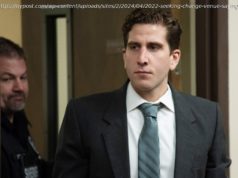Mr. Roth wrote of the everyday people, buildings, streets and mores of the city, often with palpable and wistful affection.
NEWARK — Roberta Harrington, a retired nurse of the same vintage as Philip Roth, remembers a visit a year ago by Mr. Roth to his clapboard boyhood home, which she now lives in, on Summit Avenue. He recalled with pleasure the many times that as a child “he’d run up the stairs and come back down again” just for the fun of it and how he prized a cherry tree that was no longer there.
That house, that quiet tree-lined street, that neighborhood, this treasured city was the setting of many of Mr. Roth’s novels just as William Faulkner set many of his stories in the region around his hometown, Oxford, Miss. Though Faulkner used the fictional name Yoknapatawpha County, Mr. Roth, who died Tuesday at 85, rarely bothered to camouflage Newark in any way.
In his breakthrough debut novella, “Goodbye, Columbus,” his alter ego Neil Klugman, working at the Newark Public Library for a summer, is bewitched by the fetching and much better-heeled Brenda Patimkin. In “American Pastoral,” another Roth stand-in, Nathan Zuckerman, idolizes Swede Levov, the star athlete of Weequahic High School, a character based on the school’s real-life star athlete when Mr. Roth attended in the 1940s. His last novel, “Nemesis,” recalls the panic that enveloped his tightly knit Jewish neighborhood in 1944 when a polio epidemic maimed and paralyzed some of its children.
Mr. Roth was regarded with Saul Bellow, John Updike and one or two others as the titans of American literature of the second half of the 20th century. He earned that regard, in part, by milking the everyday people, buildings, streets and mores of the humble Weequahic neighborhood and other city landmarks, often with palpable and wistful affection.
“This passion for specificity, for the hypnotic materiality of the world one is in is all but at the heart of the task to which every American novelist has been enjoined since Herman Melville and his whale and Mark Twain and his river: to discover the most arresting, evocative verbal depiction for every last American thing,” Mr. Roth said when he celebrated his 80th birthday in Newark in 2013.
Nevertheless, on Wednesday there were no large turnouts of mourners or literary fans at the Rothian sites, no shrines of flowers. The Weequahic neighborhood and much of the city was transformed after Mr. Roth’s youth by white flight to the suburbs, particularly after the riots of 1967 left more than two dozen people dead and scores of stores along the commercial spine of Springfield Avenue torched or looted. The riots are among several historic events described in “American Pastoral,” which centers on how the 1960s’ national cultural and political turbulence destroys Levov’s family.
For the last 50 years, most of the residents of the Weequahic neighborhood, which borders the suburbs of Hillside and Irvington, have been African-Americans, not Jews. Ms. Harrington’s niece, Rhonda Hughes, says it is still a middle-class block of homeowning families trying to scratch out a living and enjoy a few comforts and pleasures. The block and surrounding streets are inhabited by postal workers, home health aides, nurses and teachers, many now retired.
The city itself is in the midst of a renaissance with booming development, less crime and falling unemployment, and is on Amazon’s list of possible sites for a second headquarters. Mayor Ras J. Baraka, buoyed by the resurgence, was easily re-elected this month.
“This is one of the nicest quietest blocks,” said Ms. Hughes (“H like Howard but without the dollars”), who before retiring was a coordinator of commercials at WCBS-TV in Manhattan. “After dark you hear nothing but traffic. When it snows, kids will come over and shovel for free.”
Of course, children no longer play in the streets the way they did in Mr. Roth’s day, preferring indoor activities like television and roaming the internet. But that is true everywhere in America, she said. Practically every house, including Mr. Roth’s, seems to have a TV dish antenna.
Ms. Hughes is an avid reader, but her bookshelves indicate her tastes for fiction run more to Ralph Ellison’s “Invisible Man” and Alice Walker’s “The Color Purple” than Mr. Roth’s.
The central library downtown plans a structure to house Mr. Roth’s voluminous private book collection, which he willed to the library. The high school, built in 1932, is proud of its mocha-colored Art Deco facade, the same it had in Mr. Roth’s day, and the kind of W. P. A. mural that graced the lobbies of many Depression-era public buildings.
Myra Lawson, executive director of the school’s alumni association, produced a yearbook from Mr. Roth’s 1950 graduating class. Under his photograph of a young man with an exuberant smile, it reads, “A boy of real intelligence, combined with wit and common sense,” and lists activities he took part in like the school newspaper and prom committee.
Andre Hollis, the principal, said Mr. Roth’s name was invoked sometimes at a weekly convocation of the school’s teachers, at which he might cheer them on by saying of Mr. Roth: “Because greatness came forth from the school, greatness can still come forth from the school. You can be that Philip Roth.”
For two years the school has had a Philip Roth Book Club with 10 to 15 students. Ofelia Pancarician, an English teacher who belongs to a family that immigrated from the former Yugoslavia and the club’s adviser, said the students liked the first year’s book, “Goodbye, Columbus” because it was a love story, but attendance flagged this year when “The Plot Against America” was featured. That novel imagines an America where an anti-Semitic, authoritarian Charles Lindbergh defeats Franklin D. Roosevelt for the presidency and begins persecuting Jews. Including the Roth family — their actual name in the book, and the narrator is their son Philip — of Newark.
“They had difficulty with the historical context,” Ms. Pancarician said.
She brought in two teachers to debate the book. One argued that it had echoes of America under President Trump, with the administration’s tendency to spout falsehoods and drum up ”animosity toward the other” — like Mexican immigrants who don’t reflect the majority of American society.






